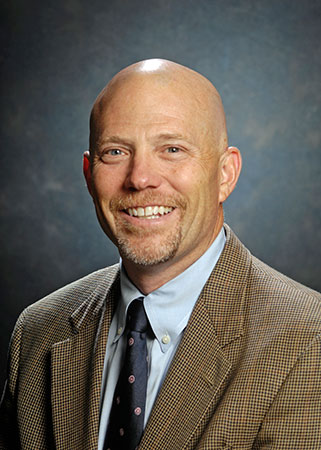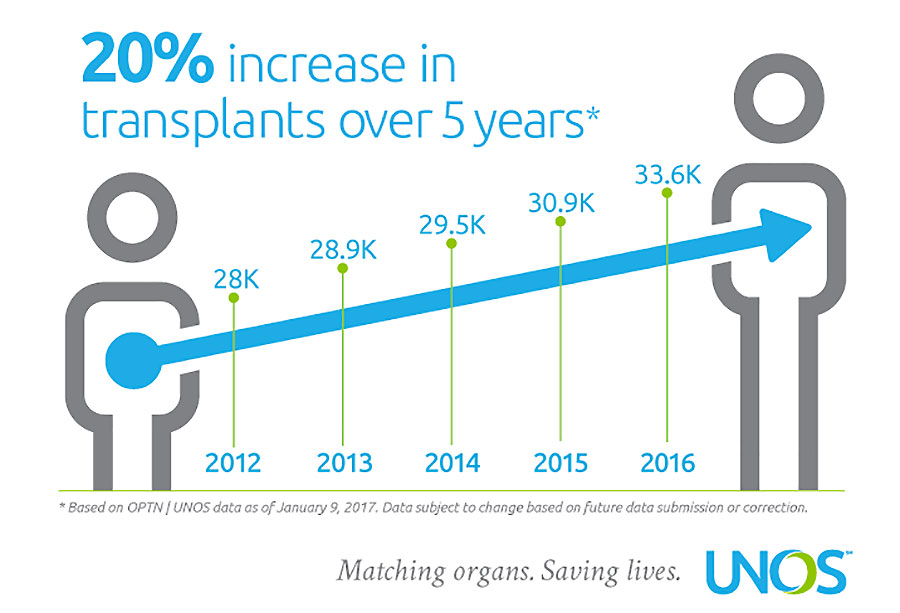 Organ transplants performed at the University of Alabama at Birmingham and across the United States in 2016 reached record highs, according to preliminary data from UAB and the United Network for Organ Sharing.
Organ transplants performed at the University of Alabama at Birmingham and across the United States in 2016 reached record highs, according to preliminary data from UAB and the United Network for Organ Sharing.
UAB performed 385 transplants in 2016 — up more than 4 percent from 2015 — including a 25 percent jump in the volume of liver transplants performed at UAB Hospital. UAB’s numbers are up in part because of the Alabama Organ Center’s record year, which saw 153 organ donors donate 425 organs upon death — a 24 percent increase from 2015. Nationwide, 33,606 transplants were reported to UNOS, representing an 8.5 percent increase over the 2015 total, and an increase of 19.8 percent since 2012.
Devin Eckhoff, M.D., director of UAB’s Division of Transplantation, part of the Department of Surgery and School of Medicine, says exceeding local and national records is not possible without the selfless decision thousands of people made to become either a living organ donor or an organ donor upon death.
“Truly, these aren’t numbers,” Eckhoff said. “They are people, and they are people here in Alabama and around the country who physicians have had the privilege of helping return to health, in some cases for the first time in years because of the generosity of another human being. As a transplant surgeon, it’s a tremendous honor to help carry on the legacy of those who made a decision to give so others can have a chance to live.”
“The Alabama Organ Center has been focused on transforming itself to better meet the needs of the community, and we are seeing the positive results of those efforts,” said Chris Meeks, executive director Alabama Organ Center, which became only the eighth procurement organization in the country to open its own in-house recovery center in 2016. “We exceeded the national growth performance in 2016 and are now focusing on continued growth and sustaining our service to our mission. We are grateful to our hospital and community partners that help to make this possible. We are especially humbled by the generous nature of the residents of Alabama who register their decision to be donors, and to all of the families who support organ, eye and tissue donation.”
Today, more than 123,000 candidates are on the national organ transplant waiting list, with nearly 3,200 waiting in Alabama. UAB’s transplant program has performed more than 14,000 transplants during the past 50 years. UAB Medicine offers transplant surgery for heart, liver, lung, pancreas and kidneys.
Eckhoff says the UAB’s Liver Transplant Program’s increase in the volume of transplants by 25 percent from 2015 to 2016 was due to several factors, including UAB’s aggressive pursuit of livers that have been turned down at other centers for a variety of reasons.
“We pursue increased-risk donors, for example, where the risk of dying on the transplant list is far greater than the risk these donors may present for the recipients,” Eckhoff said. “We also had two donors this past year where the CT scan showed a fatty liver, which is not transplantable. But we will go look at these donors closely, and our experience is that fatty liver is frequently over-diagnosed and, in fact, the livers were normal.”
Eckhoff says UAB’s liver program hopes to at least sustain its volume and, hopefully, increase it slightly if the current allocation system remains in place.
UAB is the only liver transplant center in Alabama and one of only 20 nationally that average 100 or more liver transplants annually. Liver transplants are complex, lengthy surgeries that involve several surgeons, anesthesiologists and nurses, and they require a donor whose size and blood type are similar to the recipient’s.
UAB’s Heart Transplant Program is one of the most distinguished programs of its kind in the nation since the first heart transplant in the Southeast was performed at UAB in 1981. Since then, hundreds of heart transplants have been performed at UAB. Patients also are cared for in a state-of-the-art, 23-bed Heart Transplant Intensive Care Unit, which is one of only a few of its kind in the nation.
The Lung Transplant Program at UAB is one of approximately 65 active programs in the United States. Since 1989, UAB has performed more than 600 lung transplants, which places it among the 10 busiest centers in the nation.

UAB’s Kidney Transplant Program began in 1968 and is one of the busiest in the nation. The program averages almost 300 transplants per year. It boasts an incompatible transplant program and recently performed the Deep South’s first HIV-positive to HIV-positive kidney transplant. The program also continues its UAB Kidney Chain, which began with a single, altruistic donor to grow into the longest chain of transplants ever performed. It is currently at 67 transplant recipients with more planned for 2017.
“From performance of its first transplant in 1968 through implementation of the new ECMO program for lung transplant candidates and ABO- and HLA-incompatible kidney transplantation — both landmark advances realized in 2013 — UAB has a rich tradition in solid organ transplantation,” said Robert Gaston, M.D., executive director of UAB’s Comprehensive Transplant Institute, which was founded in 2011. “Several therapies now used around the world to prevent transplant rejection were first offered to patients at UAB. We strive to produce a culture of excellence for our patients that permeates transplantation at UAB, promoting state-of-the-art care and research across all organ systems.”
Read more about all of UAB’s transplant services.
UAB transplant successes continue
|
According to UNOS, the growth in overall transplants nationwide for 2016 was driven largely by an increase of 9.2 percent in the number of deceased donors from 2015 to 2016, continuing a six-year trend of annual increases. Many deceased donors provide multiple organs for transplantation. Approximately 82 percent (27,628) of the transplants involved organs from deceased donors. The remaining 18 percent (5,978) were performed with organs from living donors.
In addition, an increasing number of deceased donors in 2016 had medical characteristics or a medical history that, in prior years, may have been considered less often by clinicians. These include people who donated after circulatory death as opposed to brain death, as well as donors who died of drug intoxication or those identified as having some increased risk for bloodborne disease.
What kind of impact can one person make as an organ donor? According to the U.S. Government Information on Organ Donation and Transplantation, one organ donor can save as many as eight lives. A single tissue donor can save and heal 50 others through needed heart valves, corneas, skin, bone and tendons that mend hearts, prevent or cure blindness, heal burns, and save limbs.
Kidneys, heart, lungs, liver, pancreas and intestines can be donated along with stem cells, tissue, blood and platelets.
Register with the Alabama Organ Center today to be an organ, eye and tissue donor. To register or find out more information on how to be a living kidney donor, fill out UAB Medicine’s Living Kidney Donor Screening Form.